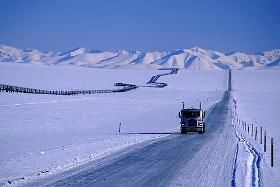Oh Canada
Topic 15081 | Page 1
Hear, hear! I just did my first Canada load to Bonnyville, Alberta, then deadheaded down to BC for a load before getting back to the US. I wouldn't have been able to drive one of the four days I was there because of the difference in the 70-hour rule. I'm going to tell my dispatcher that I'm up for any Canada loads he has going out of our region.
The only thing that gave me a headache was the metric system. I learned it when I was a teenager, but I sure can't think in it. Quick, can you legally haul a 22,000 kg load into the US if your empty weight is 30,000 pounds? Or, the ramp maximum is 60 km/h. You're traveling at 62 mph. What gear do you need to get down to?

Deadhead:
To drive with an empty trailer. After delivering your load you will deadhead to a shipper to pick up your next load.
Dispatcher:
Dispatcher, Fleet Manager, Driver Manager
The primary person a driver communicates with at his/her company. A dispatcher can play many roles, depending on the company's structure. Dispatchers may assign freight, file requests for home time, relay messages between the driver and management, inform customer service of any delays, change appointment times, and report information to the load planners.DAC:
Drive-A-Check Report
A truck drivers DAC report will contain detailed information about their job history of the last 10 years as a CDL driver (as required by the DOT).
It may also contain your criminal history, drug test results, DOT infractions and accident history. The program is strictly voluntary from a company standpoint, but most of the medium-to-large carriers will participate.
Most trucking companies use DAC reports as part of their hiring and background check process. It is extremely important that drivers verify that the information contained in it is correct, and have it fixed if it's not.

Pounds to KG is pretty easy, just multiply by 2.2. That's "in your head" bankers math.
Speeds you just kind of have to get a feel for. My GPS does a really good job converting it for me into MPH.
Pounds to KG is pretty easy, just multiply by 2.2. That's "in your head" bankers math.
Speeds you just kind of have to get a feel for. My GPS does a really good job converting it for me into MPH.
Yep, I relied on my GPS to convert to mph, but ramp signs had me glancing a lot at the tiny km/h numbers inside the bigger mph numbers on my speedometer.
Here's the other one: the low bridge sign says 4.2 meters. OK to go? I have a midroof and my load was lower than that, so I figured I was good down to 3.5 or 3.6 meters, but pulling a box would be different in that scenario.
Also, how wide is your truck in tenths of meters, for those times when there's construction and the lanes are narrow? Stuff to know before you roll up there.
HOS:
Hours Of Service
HOS refers to the logbook hours of service regulations.
... the ramp maximum is 60 km/h. You're traveling at 62 mph. What gear do you need to get down to?
The simple way to convert km/h to mi/h, multiply by .6. That decimal is tricky for some so just drop the least significant digit (in every case a zero) and multiply by six, so in Bud A's case (what is 60 km/h?) 6 x 6 = 36 mi/h
In a city or town in Ontario the speed limit is 50 km/h unless posted otherwise. That is 30 mi/h.
km/h - mi/h (Easy)
50 - 30
60 - 36 (35)
70 - 42 (40)
80 - 48 (45)
90 - 53 (55)
100 - 60
105 - 63 (65) This is not a posted speed, but it is the speed close to which most truckers drive. If you drive this fast you'll be with the flow of truck traffic on the 400 series highways in Ontario.
Why the big jump between 80 and 90 km/h, well that's because .6 is an approximation of the real ratio (to six digits 0.621371), and the errors in the approximation broke the rounding I gave.
New Reply:
New! Check out our help videos for a better understanding of our forum features

















Preview:








 TT On Facebook
TT On Facebook
I've recently completed several cross-border loads to Canada. One delivering to Blackie, Alberta and three picking up in Quebec. I must say I really like the HOS rules up there. Much more flexible and you can get more done without feeling like you're rushing.
HOS:
Hours Of Service
HOS refers to the logbook hours of service regulations.